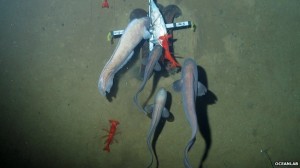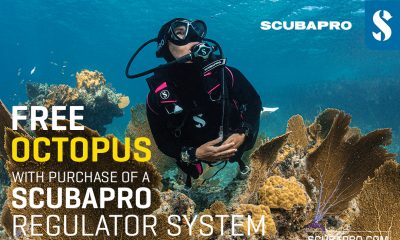News
Images Reveal a Previously Unexplored Deep Sea Trench
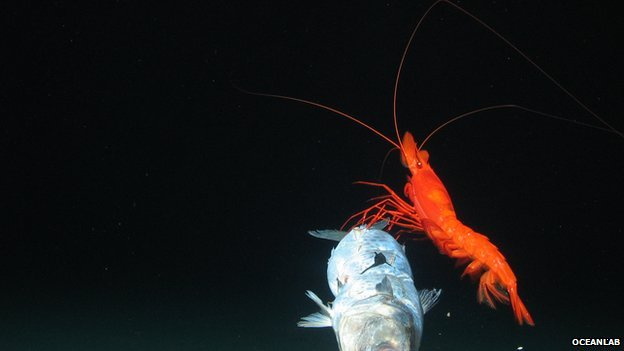
Scientists have had the first look at the life that thrives in one of the deepest spots in the ocean.
An expedition to the unexplored New Hebrides trench in the Pacific has revealed that cusk eels and crustaceans teem more than 7,000m (23,000ft) down.
The team used an unmanned lander fitted with cameras to film the deep-sea creatures.
The scientists said the ecology of this trench differed with other regions of the deep that had been studied.
“We’re starting to find out that what happens at one trench doesn’t necessarily represent what happens in all the trenches,” said Dr Alan Jamieson, from Oceanlab at the University of Aberdeen, UK, who carried out the expedition with the National Institute of Water and Atmospheric Research in New Zealand.
There are more than 30 deep-sea trenches around the world, and most of these narrow fissures in the seafloor lie in the Pacific Ocean.
Until this expedition, the depths of New Hebrides trench, which sits about 1,500km (1,000 miles) north of New Zealand, had not been explored.
The footage captured by the team during the 30-day voyage at the end of 2013 shows large, grey cusk eels, some 1m-long, chomping on the bait that had been attached to the lander.
The fish mingle with large, bright red prawns scrabbling around on the sandy seabed, which plunges down to 7,200m at its deepest point.
They also spotted eel pouts, arrow-tooth eels and thousands of smaller crustaceans, some of which were collected and brought back to the surface.
However, the team noted marked differences when they compared this trench with others they have studied, which include the Japan trench, the Izu-Bonin trench and the Kermadec among others.
Dr Jamieson said: “The surprising thing was that there was a complete and utter lack of one of the most common deep sea fish we would expect to see. Anywhere else around the Pacific Rim, around the trenches we’ve looked at, you see a lot of grenadiers – they are quite a conspicuous part of the deep-sea community. But when we went to the New Hebrides trench, we didn’t see a single one.
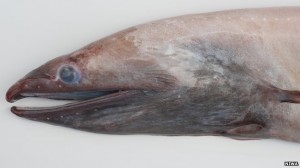 “But what we did see was a fish called the cusk eel. These turn up elsewhere but in very, very low numbers. But around the New Hebrides trench, these – and the prawns – were all that we saw.”
“But what we did see was a fish called the cusk eel. These turn up elsewhere but in very, very low numbers. But around the New Hebrides trench, these – and the prawns – were all that we saw.”
There was also an absence of snail fish, a small pink fish usually seen in the deepest depths of ocean trenches.
The researchers believe the differences are driven by how nutrient-rich the region of ocean above the trenches is.
“If you look at the New Hebrides trench, and where it is geographically, it lies under very unproductive waters – there is not a lot happening at the surface of the tropical waters,” said Dr Jamieson.
“It seems the cusk eels are specialists in very low food environments, whereas the grenadiers require a greater source of food.”
This expedition forms part of a new wave of exploration of the deep ocean.
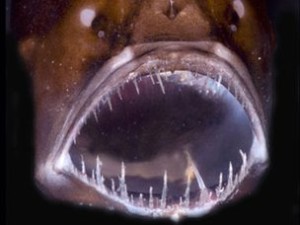 Almost all of this has been carried out using landers or underwater robots, but in 2012, Hollywood movie director James Cameron made a record-breaking dive to the deepest place in the ocean – the Mariana trench.
Almost all of this has been carried out using landers or underwater robots, but in 2012, Hollywood movie director James Cameron made a record-breaking dive to the deepest place in the ocean – the Mariana trench.
He described it as an alien place, devoid of life. This may be because it lies so far from the continental shelf, which means very few nutrients drift down into the trench, which is nearly 11km deep, making food extremely scarce.
But while larger creatures may be absent, scientists recently revealed that microscopic life is plentiful at the bottom of the Mariana trench.
Source: www.bbc.co.uk/news
Gear News
Scubapro Free Octopus Promotion 2024

Free Octopus with every purchase of a SCUBAPRO regulator system
Just in time for the spring season, divers can save money with the FREE OCTOPUS SPRING PROMOTION! Until July 31st SCUBAPRO offers an Octopus for free
with every purchase of a regulator system!
Get a free S270 OCTOPUS with purchase of these combinations:
MK25 EVO or MK19 EVO with A700
MK25 EVO or MK19 EVO with S620Ti
MK25 EVO or MK19 EVO with D420
MK25 EVO Din mit S620Ti-X
Get a free R105 OCTOPUS with purchase of the following combinations:
MK25 EVO or MK19 EVO with G260
MK25 EVO or MK17 EVO with S600
SCUBAPRO offers a 30-year first owner warranty on all regulators, with a revision period of two years or 100 dives. All SCUBAPRO regulators are of course certified according to the new European test standard EN250-2014.
Available at participating SCUBAPRO dealers. Promotion may not be available in all regions. Find an authorized SCUBAPRO Dealer at scubapro.com.
More information available on www.scubapro.com.
Blogs
Northern Red Sea Reefs and Wrecks Trip Report, Part 3: The Mighty Thistlegorm

Jake Davies boards Ghazala Explorer for an unforgettable Red Sea diving experience…
Overnight, the wind picked up, making the planned morning dive a bit bumpy on the Zodiacs to the drop point on Thomas Reef. There, we would dive along the reef before descending through the canyon and then passing under the arch before ascending the wall with a gentle drift. The site provided great encounters with more pelagic species, including shoals of large barracuda, tuna, and bigeye trevally.
Once back on the boat, it was time to get everything tied down again as we would head back south. This time, with the wind behind us, heading to Ras Mohammed to dive Jackfish Alley for another great gentle drift wall dive before then heading up the coast towards the Gulf of Suez to moor up at the wreck of the Thistlegorm. This being the highlight wreck dive of the trip and for many onboard, including myself, it was the first time diving this iconic wreck. I had heard so much about the wreck from friends, and globally, this is a must on any diver’s list. Fortunately for us, there was only one other boat at the site, which was a rarity. A great briefing was delivered by Ahmed, who provided a detailed background about the wreck’s history along with all the required safety information as the currents and visibility at the site can be variable.

Kitting up, there was a lot of excitement on deck before entering the water and heading down the shoreline. Descending to the wreck, there was a light northerly current which reduced the visibility, making it feel more like the conditions that can be found off the Welsh coast. At 10m from the bottom, the outline of the wreck appeared as we reached the area of the wreck which had been bombed, as our mooring line was attached to part of the propeller shaft. Arriving on deck, instantly everywhere you looked there were many of the supplies which the ship was carrying, including Bren Carrier tanks and projectiles that instantly stood out.

We headed around the exterior, taking a look at the large propeller and guns mounted on deck before entering the wreck on the port side to take a look in the holds. It was incredible to see all the trucks, Norton 16H, and BSA motorcycles still perfectly stacked within, providing a real snapshot in time.

Overall, we had four dives on the Thistlegorm, where for all of the dives we were the only group in the water, and at times, there were just three of us on the whole wreck, which made it even more special, especially knowing that most days the wreck has hundreds of divers. Along with the history of the wreck, there was plenty of marine life on the wreck and around, from big green turtles to batfish, along with shoals of mackerel being hunted by trevally. Some unforgettable dives.

The final leg of the trip saw us cross back over the Suez Canal to the Gobal Islands where we planned to stay the night and do three dives at the Dolphin House for the potential of sharing the dive with dolphins. The site, which included a channel that was teeming with reef fish, especially large numbers of goatfish that swam in large shoals along the edge of the reef. These were nice relaxing dives to end the week. Unfortunately, the dolphins didn’t show up, which was okay as like all marine life they are difficult to predict and you can’t guarantee what’s going to be seen. With the last dive complete, we headed back to port for the final night where it was time to clean all the kit and pack before the departure flight the next day.

The whole week from start to finish on Ghazala Explorer was amazing; the boat had all the facilities you need for a comfortable week aboard. The crew were always there to help throughout the day and the chefs providing top quality food which was required after every dive. The itinerary providing some of the best diving with a nice mixture of wreck and reef dives. I would recommend the trip to anyone, whether it’s your first Red Sea liveaboard in the Red Sea or you’re revisiting. Hopefully, it’s not too long before I head back to explore more of the Red Sea onboard Ghazala Explorer.

To find out more about the Northern Red Sea reef and wrecks itineraries aboard Ghazala Explorer, or to book, contact Scuba Travel now:
Email: dive@scubatravel.com
Tel: +44 (0)1483 411590
Photos: Jake Davies / Avalon.Red
-

 News3 months ago
News3 months agoHone your underwater photography skills with Alphamarine Photography at Red Sea Diving Safari in March
-

 News3 months ago
News3 months agoCapturing Critters in Lembeh Underwater Photography Workshop 2024: Event Roundup
-

 Marine Life & Conservation Blogs2 months ago
Marine Life & Conservation Blogs2 months agoCreature Feature: Swell Sharks
-

 Blogs2 months ago
Blogs2 months agoMurex Resorts: Passport to Paradise!
-

 Blogs2 months ago
Blogs2 months agoDiver Discovering Whale Skeletons Beneath Ice Judged World’s Best Underwater Photograph
-

 Marine Life & Conservation2 months ago
Marine Life & Conservation2 months agoSave the Manatee Club launches brand new webcams at Silver Springs State Park, Florida
-

 Gear Reviews3 months ago
Gear Reviews3 months agoGear Review: Oceanic+ Dive Housing for iPhone
-

 Gear Reviews2 weeks ago
Gear Reviews2 weeks agoGEAR REVIEW – Revolutionising Diving Comfort: The Sharkskin T2 Chillproof Suit


